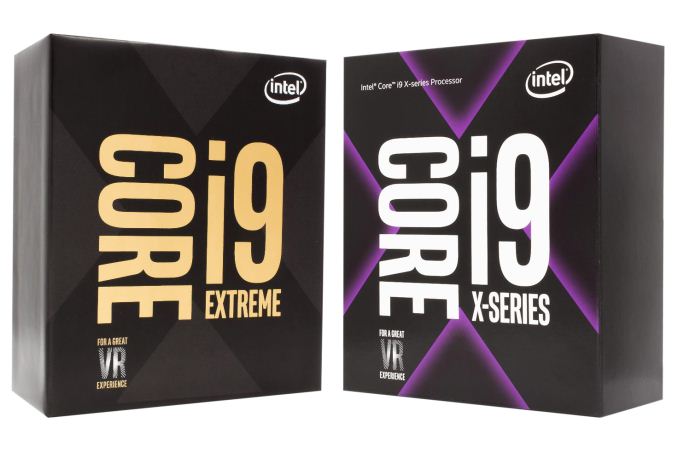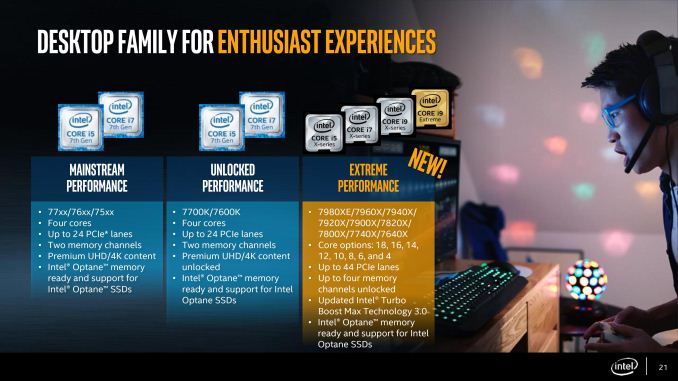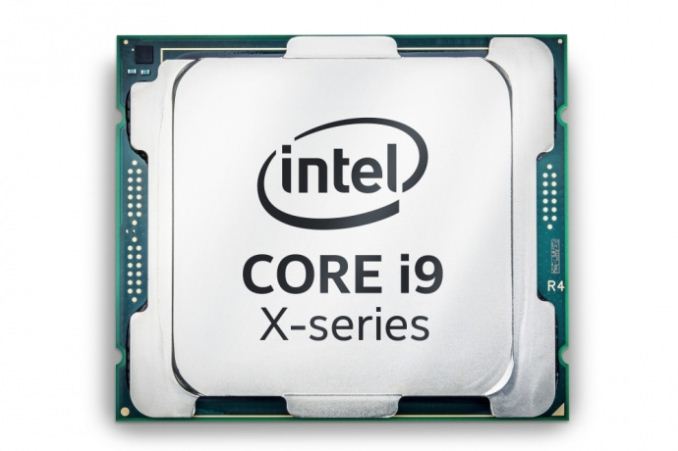Intel Announces Skylake-X: Bringing 18-Core HCC Silicon to Consumers for $1999
by Ian Cutress on May 30, 2017 3:03 AM EST
There are days in this profession in which I am surprised. The longer I stay in the technology industry, they become further and further apart. There are several reasons to be surprised: someone comes out of the blue with a revolutionary product and the ecosystem/infrastructure to back it up, or a company goes above and beyond a recent mediocre pace to take on the incumbents (with or without significant financial backing). One reason is confusion, as to why such a product would ever be thought of, and another is seeing how one company reacts to another.
We’ve been expecting the next high-end desktop version of Skylake for almost 18 months now, and fully expected it to be an iterative update over Broadwell-E: a couple more cores, a few more dollars, a new socket, and done. Intel has surprised us with at least two of the reasons above: Skylake-X will increase the core count of Intel’s HEDT platform from 10 to 18.
The Skylake-X announcement is a lot to unpack, and there are several elements to the equation. Let’s start with familiar territory: the first half of the processor launch.
Announcement One: Low Core Count Skylake-X Processors
The last generation, Broadwell-E, offered four processors: two six-core parts, an eight-core part, and a top-tier 10-core processor. The main difference between the two six-core parts was the PCIe lane count, and aside from the hike in pricing for the top-end SKU, these were iterative updates over Haswell-E: two more cores for the top processor.
This strategy from Intel is derived from what they call internally as their ‘LCC’ core, standing for ‘low core count’. The enterprise line from Intel has three designs for their silicon – a low core count, a high core count, and an extreme core count: LCC, HCC, and XCC respectively. All the processors in the enterprise line are typically made from these three silicon maps: a 10-core LCC silicon die, for example, can have two cores disabled to be an 8-core. Or a 22-core XCC die can have all but four cores disabled, but still retain access to all the L3 cache, to have an XCC processor that has a massive cache structure. For the consumer HEDT platform, such as Haswell-E and Broadwell-E, the processors made public were all derived from the LCC silicon.
The first half of the Skylake-X processor llineup follows this trend. Intel will launch four Skylake-X processors based on the LCC die, which for this platform will have a maximum of 12 cores. All processors will have hyperthreading.
| Skylake-X Processors (Low Core Count Chips) | ||||
| Core i7-7800X | Core i7-7820X | Core i9-7900X | Core i9-7920X | |
| Cores/ Threads |
6/12 | 8/16 | 10/20 | 12/24 |
| Base Clock | 3.5 GHz | 3.6 GHz | 3.3 GHz | TBD |
| Turbo Clock | 4.0 GHz | 4.3 GHz | 4.3 GHz | TBD |
| TurboMax Clock | N/A | 4.5 GHz | 4.5 GHz | TBD |
| L3 | 8.25 MB | 11 MB | 13.75 MB | TBD (Likely 13.75 MB) |
| PCIe Lanes | 28 | 44 | TBD (Likely 44) |
|
| Memory Channels | 4 | |||
| Memory Freq | DDR4-2400 | DDR4-2666 | TBD | |
| TDP | 140W | TBD | ||
| Price | $389 | $599 | $999 | $1199 |
The bottom processor is the Core i7-7800X, running at 3.5 GHz with a 4.0 GHz turbo. This design will not feature Intel’s new ‘favored core’ Turbo 3.0 technology (more on that below), but will have six cores, support quad-channel memory at DDR4-2400, come in at a TDP of 140W, have 28 PCIe lanes, and retail for around $400. This processor will be the entry level model, for any user who needs the benefit of quad-channel memory but perhaps doesn’t need a two-digit number of cores or has a more limited budget.
Next up is the Core i7-7820X, which hits a potential sweet spot in the LCC design. This is an eight-core processor, with the highest LCC base clock of 3.6 GHz and the joint-highest turbo settings: 4.3 GHz for regular turbo and 4.5 GHz for favored core. Unlike the previous processor, this CPU gets support for DDR4-2666 memory.
However in another break from Intel’s regular strategy, this CPU will only support 28 PCIe lanes. Normally only the lowest CPU of the HEDT stack would be adjusted in this way, but Intel is using the PCIe lane allocation as another differentiator as a user considers which processor in the stack to go for. This CPU also runs in at 140W, and comes in at $600. At this price, we would expect it to be competing directly against AMD’s Ryzen 7 1800X, which will be the equivalent of a generation behind in IPC but $100 cheaper.
| Comparison: Core i7-7820X vs. Ryzen 7 1800X | ||
| Intel Core i7-7820X |
Features | AMD Ryzen 7 1800X |
| 8 / 16 | Cores/Threads | 8 / 16 |
| 3.6 / 4.3GHz (4.5 GHz TMax) |
Base/Turbo | 3.6 / 4.0 GHz |
| 28 | PCIe 3.0 Lanes | 16 |
| 11 MB | L3 Cache | 16 MB |
| 140 W | TDP | 95 W |
| $599 | Price (MSRP) | $499 |
The third processor is also a change for Intel. Here is the first processor bearing the new Core i9 family. Previously we had Core i3, i5 and i7 for several generations. This time out, Intel deems it necessary to add another layer of differentiation in the naming, so the Core i9 naming scheme was the obvious choice. If we look at what the Core i9 name brings to the table, the obvious improvement is PCIe lanes: Core i7 processors will have 28 PCIe lanes, while Core i9 processors will have 44 PCIe lanes. This makes configuring an X299 motherboard a little difficult: see our piece on X299 to read up on why.
Right now the Core i9-7900X is the only Core i9 with any details: this is a ten core processor, running with a 3.3 GHz base, a 4.3 GHz turbo and a 4.5 GHz favored core. Like the last processor, it will support DDR4-2666 and has a TDP of 140W. At this level, Intel is now going to charge $100/core, so this 10-core part runs in at a $999 tray price ($1049 retail likely).
One brain cell to twitch when reading this specification is the price. For Ivy Bridge-E, the top SKU was $999 for six-cores. For Haswell-E, the top SKU was $999 for eight-cores. For Broadwell-E, we expected the top SKU for 10-cores to be $999, but Intel pushed the price up to $1721, due to the way the enterprise processors were priced. For Skylake-X, the new pricing scheme is somewhat scrapped again. This 10-core part is now $999, which is what we expected the Broadwell-E based Core i7-6950X to be. This isn’t the top SKU, but the pricing comes back down to reasonable levels.
Meanwhile for the initial launch of Skylake-X, it is worth noting that this 10-core CPU, the Core i9-7900X, will be the first one available to purch. More on that later.
Still covering the LCC core designs, the final processor in this stack is the Core i9-7920X. This processor will be coming out later in the year, likely during the summer, but it will be a 12-core processor on the same LGA2066 socket for $1199 (retail ~$1279), being part of the $100/core mantra. We are told that Intel is still validating the frequencies of this CPU to find a good balance of performance and power, although we understand that it might be 165W rather than 140W, as Intel’s pre-briefing explained that the whole X299 motherboard set should be ready to support 165W processors.
In the enterprise space, or at least in previous generations, Intel has always had that processor that consumed more power than the rest. This was usually called the ‘workstation’ processor, designed to be in a single or dual socket design but with a pumped up frequency and price to match. In order for Intel to provide this 12-core processor to customers, as the top end of the LCC silicon, it has to be performant, power efficient, and come in at reasonable yields. There’s a chance that not all the factors are in place yet, especially if they come out with a 12-core part that is clocked high and could potentially absorb some of their enterprise sales.
Given the expected timing and launch for this processor, as mentioned we were expecting mid-summer, that would have normally put the crosshairs into Intel’s annual IDF conference in mid-August, although that conference has now been canned. There are a few gaming events around that time to which Intel may decide to align the launch to.












203 Comments
View All Comments
n31l - Sunday, June 4, 2017 - link
not sure about that.. I've just done the 'microcode' unlock of a 2695 v3 (x99 single socket system) even with such an old architecture, with all 14 cores fully stressed @3199, no core goes above 50c, they have plenty or room to move on clock rates 'if' they wanted..I think Intel is just trying to find out where 'threadripper' will fit within the market.. worst case.., all they need to do is shift 'families' left bring the E7 to E5 and stop selling E5-16xx (i7 consumer parts) with a Xeon premium (especially now v4's are locked!! How I'll miss E5-1620@4.6 with ECC memory)
Unfortunately, imho, Intel can only deal with AMD in a half-arsed manor, if they wanted they could kill AMD but then they will be broken up for being a monopoly if they do.. damned if you do, damned if you don't..
Personally I'd like to see Nvidia and Intel cross-licencing to 'officially' come to an end and for Nvidia to revive the 'Transmeta x86' IP they bought (but weren't allowed to use due to GPU licence agreement) or maybe for Microsoft to extend what's happening with windows on 'ARM' and just let NVidia lose amongst the pigeons.. or crazier still, as I believe Microsoft still has the 'golden' share option from the xbox days.. how about they buy Nvidia and make a custom 'windows CPU' and take google on head first before it's too late.. ;-)
theuglyman0war - Thursday, June 8, 2017 - link
what do u consider a hedt scenario that doesn't leverage moar cores?Workstation? A workstation creative that doesn't render interactively? Light baking complex radiosity?
If I did not scream at progress bars aLL DAY. I would have no reason to upgrade for years now. I do not see that happening in my lifetime and if I keep screaming at progress bars without relief I will eventually commit bloody criminal solutions perhaps even to my poor suffering soul. Considering 90 percent of my progress bars are wrecked everytime I advance advanced cores...
I wonder what is this hedt market that does not leverage moar cores?
3DVagabond - Monday, June 19, 2017 - link
Nah. They'll just sell their's for $999.Chaitanya - Tuesday, May 30, 2017 - link
Intel desperately scrambling for ideas.mschira - Tuesday, May 30, 2017 - link
$2000?Are they kidding? In what world do they live?
I rather get a dual socket AMD system for the same money. If I would care enough about that many thread performance.
Thank God AMD got their act back together, Intel has gone completely insane.
M.
nevcairiel - Tuesday, May 30, 2017 - link
Considering how much the 10-core BDW-E already cost before, $2000 is actually lower then I would have expected.Notmyusualid - Tuesday, May 30, 2017 - link
@nevcairielAgreed.
ddriver - Tuesday, May 30, 2017 - link
Considering it is actually a xeon they'd sell for 4000$ had there not been the desperate need to save face, 2000$ as expressive as it may be, is quite generous of intel, you know... relative to their standards for generosity...smilingcrow - Tuesday, May 30, 2017 - link
Broadwell-EP 18 Core parts start at under $2,500 so Skylake-EP or whatever it will be called will likely offer more cores per dollar and that is the comparison to be made.Intel can make as many of them as they like so selling them at 'only' $2k to prosumers hardly undermines their business model as it's not as if they will end up in true Workstations/Servers anyway.
I don't see that much financial upside or downside to Intel for HEDT parts over $1K as that's a small market.
But AMD are putting downward price pressure on the sub $1K chips which will hurt more.
Plus the 16 Core AMD part is likely usable in a Workstation/Server with it supporting ECC memory so that is another attack on Intel.
So I think you have missed the mark in giving much emphasis to these re-positioned HCC chips, the play is elsewhere.
theuglyman0war - Thursday, June 8, 2017 - link
I am hoping the $849 16 core threadripper rumor is true. As awesome as that would be it still comes down to benchmarks. A workstation u will b suffering with for 2 or 3 years because it owns now vs the hassle of upgrading the cheaper solution every year that doesn't quite own. Where that line lie with me usually depends on how impressed I am at the time saved rendering extreme complexity. Or how much those core make my pipeline more interactive/productive. The more AMD forces Intel to cannibalize the XEON line the better. Kind of bitter that AMD wasn't more hedt relevant for a while now. Kind of wonder why they did not spend the bucks on the architecture talent for all these years if that's all it took to jump start things like the current excitement. And I haven't been excited like this in a long time.